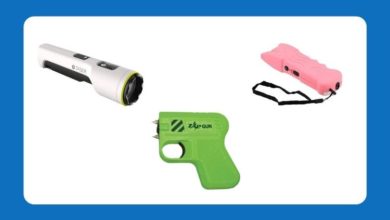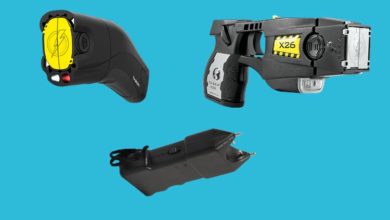Pepper Gel vs. Spray: The Ultimate Guide
KEY TAKEAWAYS
We’ve all heard about pepper spray, right? It’s that tiny but powerful tool of self-defense that leaves an assailant helpless in seconds. But did you know there’s another equally powerful variant called pepper gel?
Confused about which one to choose? Don’t worry; you’re not alone! In this comprehensive guide, we will examine the ins and outs of pepper gel and spray, their pros and cons, and provide a detailed comparison to help you make an informed decision.
What To Know About Pepper Gel
Pepper gel, often called the sophisticated cousin of pepper spray, packs the same potent punch but with a few noteworthy differences. The crucial distinguishing factor is its consistency. Unlike the misty spray of traditional pepper spray, pepper gel has a sticky, viscous consistency similar to heavy hair gel.
This thick formulation affects how the product is deployed, how it interacts with the target, and how it behaves in different environments. It’s still the same powerful capsaicin compound — the chemical that gives hot peppers their heat — but the delivery method offers some unique advantages and disadvantages.
Pros of Pepper Gel
Pepper gel, a popular choice for self-defense, has several unique advantages. Its thick consistency allows for a longer range, typically up to 18-20 feet, granting you the advantage of distance to neutralize threats. The gel’s composition significantly minimizes the risk of wind-induced blowback, making it safer to use in various conditions.
Upon impact, pepper gel clings to the assailant, causing prolonged discomfort. Its sticky nature not only ensures a sustained effect but also discourages quick removal by the attacker, adding to its effectiveness.
Cons of Pepper Gel
While pepper gel has notable advantages, it also has certain downsides. Unlike sprays, it doesn’t disperse widely, necessitating an accurate aim for maximum effectiveness. Moreover, due to its thicker consistency, its effects may take a bit longer to manifest compared to traditional sprays.
These considerations are vital when choosing between pepper gel and spray. However, despite these drawbacks, pepper gel remains popular due to its long range and reduced self-contamination risk. Effectiveness hinges on understanding its characteristics and practicing its correct use.
Unpacking Pepper Spray
What is Pepper Spray?
Pepper spray is a self-defense tool that sprays a cloud of capsaicin and the hot component of chili peppers. It irritates the eyes and respiratory system, effectively incapacitating the target.
Pros of Pepper Spray
Pepper spray has some distinct advantages that make it a suitable choice for personal defense.
Firstly, pepper spray creates a broader dispersion area, increasing the likelihood of hitting your target. Unlike pepper gel, which requires more precise aim, the spray disperses as a cloud, meaning you don’t have to be a sharpshooter to hit your target effectively. This cloud of capsaicin droplets can instantly incapacitate an attacker by affecting their eyes and respiratory system.
Secondly, pepper spray is generally quicker to take effect than pepper gel. The fine mist created by the spray can quickly cover an attacker’s face and seep into their eyes and respiratory system, causing an almost immediate burning sensation and difficulty seeing and breathing. This speed can be crucial in a self-defense scenario, giving you those essential moments to escape.
Cons of Pepper Spray
On the flip side, pepper spray can be affected by wind and may affect bystanders or even the user due to the wider dispersion.
A significant disadvantage is that pepper spray’s wide dispersion can be affected by wind. If the wind is blowing in your direction at the time of deployment, there’s a risk that the spray could blow back onto you. This blowback can lead to self-contamination, turning the spray into a liability rather than a protective measure.
Furthermore, because of its wider dispersion, pepper spray can potentially affect bystanders. If used in a crowded area, others near the spray could experience the irritating effects, leading to unintended harm to innocent people.
As with any self-defense tool, understanding the pros and cons of pepper spray is vital to using it effectively and responsibly. The best tool for you depends on your comfort, training, and specific situation.
Pepper Gel vs. Spray: A Comparative Analysis
When deciding between pepper gel and spray, consider the following factors:
Range
In terms of effective range, pepper gel typically outperforms pepper spray. This is a crucial aspect of self-defense, as maintaining distance from an attacker can significantly improve your safety.
The gel’s thicker consistency enables it to be launched further, typically effective up to a distance of 18-20 feet, compared to the shorter range of traditional sprays. This additional reach can provide crucial seconds to escape and call for help.
Wind Resistance
Another important factor to consider is the product’s performance in different environmental conditions. Pepper gel’s thicker consistency means it is less susceptible to wind interference, reducing the risk of the substance blowing back towards you.
On the contrary, pepper spray’s fine mist can be easily swayed by wind, posing a potential risk of self-contamination if the wind direction changes unexpectedly. This makes pepper gel a safer option in windy conditions or in confined spaces where the risk of blowback could be significant.
Accuracy
The dispersion patterns of pepper spray and pepper gel also impact the required accuracy when aiming. Pepper gel, due to its narrower stream, requires more precision. You need to aim directly for the face for it to be most effective.
On the other hand, pepper spray creates a wider mist, making it easier to hit an attacker’s face and respiratory system, even with a less-than-perfect aim. However, this ease of use must be weighed against the potential for collateral damage and wind interference.
Collateral Damage
The potential to affect bystanders, also known as collateral damage, is an important factor to consider when choosing between pepper spray and gel. Pepper spray’s wide dispersion means it’s more likely to affect innocent bystanders if used in a crowded or public area.
Its mist can easily be inhaled or come into contact with others’ eyes, causing discomfort or panic. Pepper gel, with its more direct stream, provides better control and reduces the risk of inadvertently causing harm to bystanders.
Usage Scenarios: When to Use Which
Pepper gel may be ideal for close quarters or indoor use where you don’t want the substance to spread too much? Pepper spray, on the other hand, might be better suited for outdoor situations where accuracy might be compromised.
Safety Precautions
Regardless of which product you choose, always remember to use them responsibly and only in self-defense. Practice using them correctly and know the legal implications in your area.
Getting to Know the Active Ingredient: Capsaicin
When discussing pepper gel and pepper spray, it’s essential to understand what makes them work: capsaicin. Capsaicin is the chemical responsible for the burning sensation we feel when eating chili peppers. It irritates mammals, including humans, and produces a burning sensation in any tissue it comes in contact with.
In both pepper gel and spray, capsaicin is suspended in a liquid (either water or oil-based), which is then pressurized within the canister. This is what gives these self-defense tools their ability to shoot out when the trigger is pressed, delivering the capsaicin to the target.
How Do They Affect the Human Body?
Pepper spray and gel cause the eyes to close due to severe irritation. If inhaled, they can cause coughing, difficulty breathing, and the sensation of a burning throat. Other effects can include runny nose, drooling, and skin irritation. These symptoms are temporary and usually last about 30 to 45 minutes.
This powerful reaction makes pepper gel and spray such effective tools for personal defense. By temporarily incapacitating an attacker, it gives the user a chance to escape and seek help.
Legal Considerations
While pepper spray and gel are legal for self-defense use in many places, there are some jurisdictions with restrictions. In some areas, there may be limitations on the size or strength of the canisters you can carry, or they might be prohibited altogether. Always check your local laws and regulations before purchasing or carrying pepper spray or gel.
Choosing the Right Product for You
Choosing between pepper spray and gel largely depends on your personal comfort and the situations in which you anticipate needing it. Here are a few additional considerations:
-
Training: If you decide to go with pepper gel, you might want to invest in some training or practice canisters to improve your accuracy.
-
Carry method: Consider how you plan to carry your self-defense tool. Do you want something that can easily attach to a keychain, or would you prefer a larger canister that fits in a bag?
-
Additional features: Some products come with additional features like UV marking dye to help police identify an attacker or a flip-top design to prevent accidental discharges.
Always remember, the best self-defense tool is the one you feel comfortable and confident using in a crisis.
Storing and Maintaining Your Pepper Spray or Gel
To ensure your self-defense tool is ready when you need it, proper storage and maintenance are crucial. Avoid exposing the canister to extreme temperatures, as this can cause the pressure to drop and the product to be less effective. Also, keep an eye on the expiration date — over time, the potency can decrease
Frequently Asked Questions
1. Is pepper gel better than spray?
Both have their unique advantages and disadvantages. The choice depends on your specific needs.
2. Does pepper gel work instantly?
Pepper gel might take a second or two longer than spray to take effect.
3. Can I carry pepper spray or gel everywhere?
This depends on the legal implications in your area. Always check local regulations.
4. Is it hard to aim with pepper gel?
Pepper gel requires more accuracy due to its narrower dispersion. Practice can help improve accuracy.
5. Can pepper spray affect the user?
Yes, especially if used against the wind or in confined spaces, it can affect the user due to blowback.
Conclusion
In the debate between pepper gel vs. spray, it’s clear that both have their strengths and weaknesses. Your choice will ultimately depend on your needs, circumstances, and comfort. Hopefully, this guide has given you some clear insights to help decide.
If you wish to learn more about the legal limits and permits you need to acquire a stun gun, read more from our blogs at Security Forward today.



